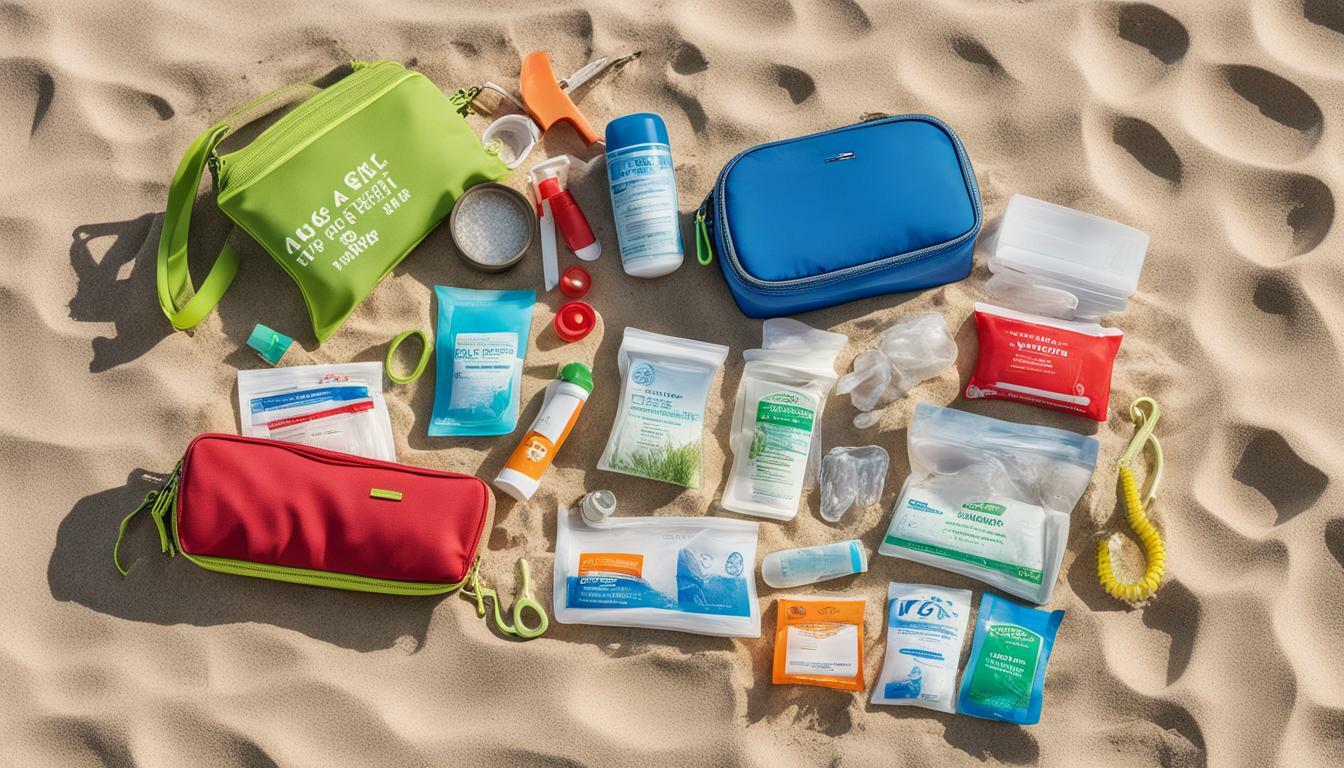Summer is a time for outdoor fun, but it’s also a time when injuries and emergencies can happen. Whether you’re going on a camping trip, hiking a mountain trail, or spending the day at the beach, it’s essential to have a first aid kit on hand.
First aid kits for summer can help with common issues like sunburns, insect bites, and more. By being prepared, you can quickly address any health problems that arise and ensure that everyone enjoys their summer activities safely.
Key Takeaways:
- First aid kits for summer are essential for addressing common issues like sunburns and insect bites.
- Be prepared for emergencies by carrying a first aid kit with you on outdoor adventures.
- Take preventative measures to avoid injuries and illnesses during the summer months.
Summer Safety Tips
Summer is a time for fun in the sun, but it’s important to take steps to stay safe and healthy in the heat. Follow these summer safety tips to enjoy all the season has to offer:
- Protect your skin. Use sunscreen with at least SPF 30 and reapply every two hours, especially after swimming or sweating. Wear protective clothing, such as long-sleeved shirts and wide-brimmed hats.
- Stay hydrated. Drink plenty of water and avoid sugary or alcoholic beverages, which can dehydrate you. Pack a water bottle when you’re out and about.
- Take breaks from the heat. Spend time in air-conditioned buildings or shady areas during the hottest parts of the day. If you’re exercising or playing sports, take frequent breaks and rest in a cool spot.
- Practice water safety. Never swim alone, and be aware of any hazards in the water, such as currents or sudden drops. Wear a life jacket if you’re boating or participating in water sports.
- Be cautious with food and drinks. Keep food properly refrigerated and avoid leaving it out in the sun for long periods of time. If you’re traveling or attending outdoor events, be aware of the risk of food poisoning and take appropriate precautions.
By following these summer safety tips, you can help prevent heat exhaustion, sunburns, and other common warm weather ailments. Enjoy the season safely!

Sunburn Relief
Summer brings the heat, but it also brings the risk of sunburns. If you’ve spent too much time in the sun, there are steps you can take to relieve the pain and discomfort of sunburns.
Step 1: Cool the skin. Take a cool bath or shower, or apply a cool, damp compress to the affected area. Avoid using ice or very cold water, as this can further irritate the skin.
Step 2: Moisturize the skin. Apply aloe vera gel or a moisturizing lotion to the affected area. This can help soothe the skin and reduce peeling.
Step 3: Take over-the-counter pain relievers. If the sunburn is causing pain or discomfort, you can take over-the-counter pain relievers like ibuprofen or acetaminophen. Be sure to follow the instructions on the label.
Step 4: Stay hydrated. Drink plenty of water to help prevent dehydration, which can make sunburns feel worse.
Of course, it’s better to prevent sunburns altogether. You can do this by seeking shade, wearing hats and protective clothing, and using sunscreen. Choose a sunscreen with an SPF of at least 30, and reapply it every two hours or after swimming or sweating.

Remember, severe sunburns can require medical attention. If you experience blistering, chills, fever, or nausea, or if the sunburn covers a large area of your body, seek medical help.
Insect Bite Treatment
Summer is prime time for pesky insects, and unfortunately, bites and stings are an inevitable part of enjoying the great outdoors. If you do get bitten, it’s important to know how to treat the affected area to minimize discomfort and prevent infection.
Step 1: Wash the area. Use soap and water to clean the area around the bite or sting. This will help prevent infection.
Step 2: Apply a topical cream or ointment. An antihistamine cream or ointment can help relieve itching and swelling. Look for products that contain ingredients like hydrocortisone, calamine, or lidocaine.
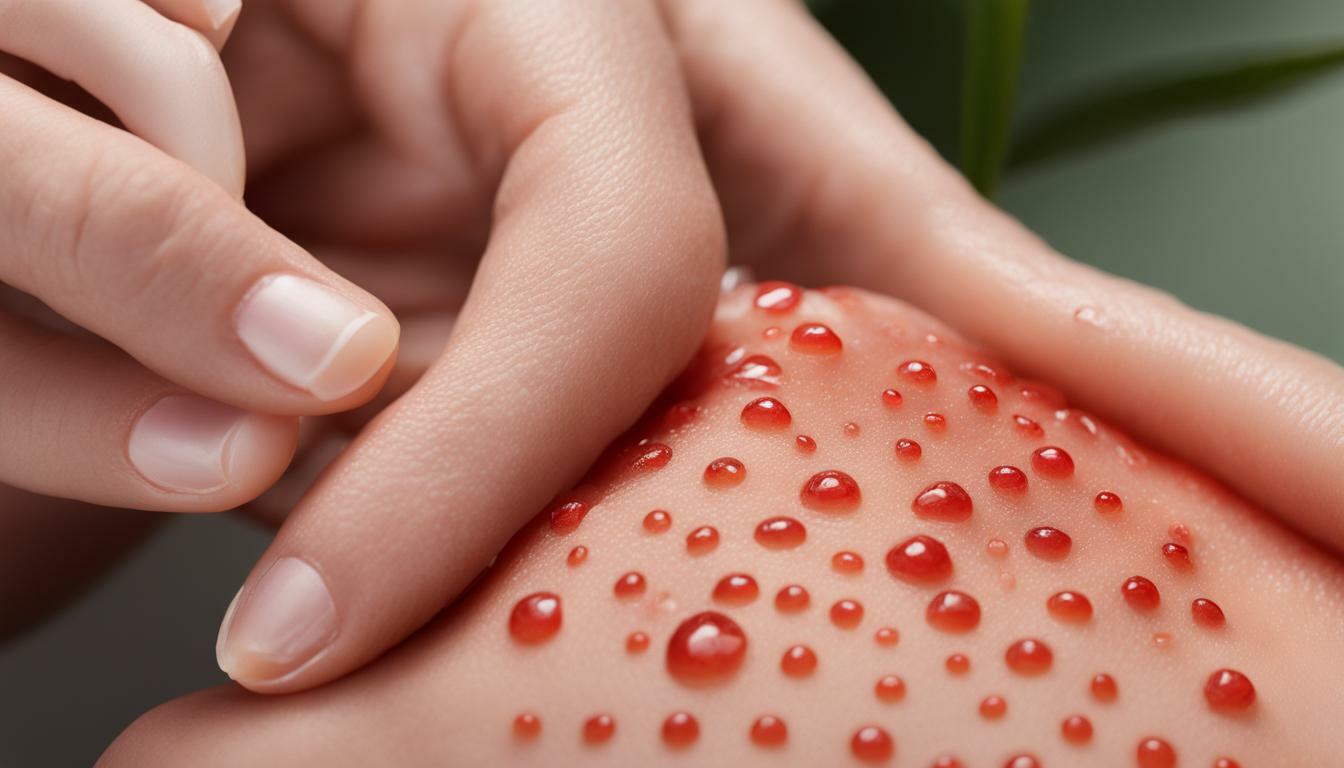
| NOTE: | If you have a severe reaction to an insect bite or sting, such as difficulty breathing or swelling of the lips or throat, seek medical attention immediately. |
|---|
Step 3: Use cold compresses. Applying a cold compress to the affected area can help reduce pain and swelling. You can use a clean cloth soaked in cold water or a bag of ice wrapped in a towel.
Step 4: Take pain relievers. Over-the-counter pain relievers like ibuprofen or acetaminophen can help relieve pain and reduce inflammation.
If the bite or sting becomes increasingly painful, red, or swollen, or if you experience symptoms like fever, headache, or muscle aches, contact your doctor. In some cases, insect bites and stings can cause a severe allergic reaction known as anaphylaxis, which can be life-threatening.
Heatstroke Prevention
As temperatures rise during summer months, it’s important to take measures to prevent heatstroke. This condition occurs when the body overheats and cannot regulate its temperature properly. Heatstroke can be life-threatening, so it’s crucial to know how to prevent it.
Stay hydrated: Drinking plenty of water is key to preventing heatstroke. Aim for at least eight glasses of water a day, and increase your intake if you’re spending time outdoors in high temperatures.
Avoid strenuous activities during the hottest part of the day: If possible, schedule outdoor activities for early morning or late evening, when temperatures are typically cooler. If you must be outside during the hottest part of the day, take frequent breaks and seek shade when possible.
Wear appropriate clothing: Lightweight, loose-fitting clothing in light colours can help keep you cool. Avoid dark colours, as they absorb heat.
Seek air-conditioned environments: When possible, spend time in air-conditioned buildings, such as shopping centres, libraries, or community centres.
If you begin to experience symptoms of heatstroke, such as dizziness, headache, or confusion, move to a cool area immediately and drink water. If symptoms persist, seek medical help right away.

Tick Bites and Lyme Disease
Tick bites can be a common risk during summer activities, especially in wooded or grassy areas. Unfortunately, some ticks may carry Lyme disease, a bacterial infection that can cause serious health problems if left untreated.
To prevent tick bites, wear long sleeves and pants when hiking or spending time outdoors. Use insect repellent containing at least 20% DEET. Check yourself and your pets for ticks after being outside, especially in hard-to-see areas like the scalp and armpits.
If you do find a tick attached to your skin, remove it immediately with fine-tipped tweezers, grasping the tick as close to the skin’s surface as possible. Pull upward with steady, even pressure. Clean the bite area with rubbing alcohol or soap and water.
Watch for symptoms of Lyme disease in the days and weeks following a tick bite, including a red “bullseye” rash, fever, chills, headache, muscle and joint pain, and fatigue. Seek medical attention if you suspect that you may have contracted Lyme disease.

Jellyfish Stings
While swimming in the ocean, getting stung by a jellyfish is a common summer hazard. If you do get stung, it’s important to act quickly to relieve the pain and prevent further injury.
The first step is to rinse the affected area with saltwater, not freshwater, to avoid triggering more stinging cells. Remove any tentacles that may be on the skin using a pair of tweezers or with the edge of a credit card. Do not use pressure or touch the tentacles with bare hands as it may cause more venom to enter the bloodstream.
If the sting is causing a lot of pain, an over-the-counter pain reliever can help. Applying a heat pack or immersing the affected area in hot water for 20 to 45 minutes may also provide relief. In case of a severe sting or an allergic reaction, seek medical attention immediately.
Remember to always be cautious when swimming in unfamiliar waters and to respect the natural environment. Take care to avoid jellyfish if possible, and know what to do in case of a sting.
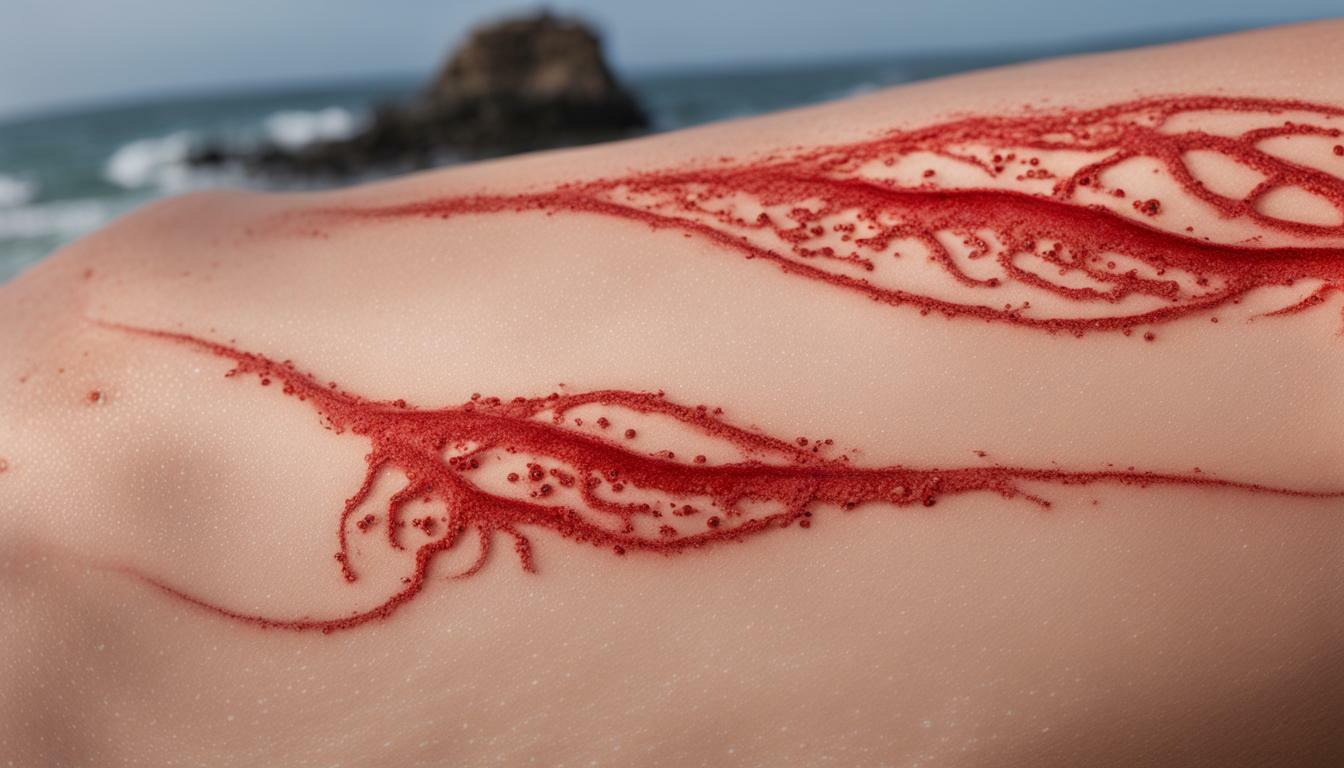
Essential First Aid Supplies
When preparing a first aid kit for summer, it’s essential to include the right supplies. Here are some must-have items to keep on hand:
| Item | Purpose |
|---|---|
| Adhesive bandages | To cover small cuts and scrapes |
| Antiseptic wipes | To clean wounds and prevent infection |
| Tweezers | To remove splinters or ticks |
| Aloe vera gel | To soothe sunburns |
| Over-the-counter pain relievers | To relieve pain and reduce fever |
| Insect repellent | To prevent insect bites |
| Cold packs | To reduce swelling and inflammation |
| Gauze pads and adhesive tape | To dress larger wounds and secure bandages |
| Scissors | To cut tape, gauze, or clothing in an emergency |
| Emergency blanket | To retain body heat and protect from the elements |
Remember to check your first aid kit regularly and replace any expired or used items. Keeping a well-stocked kit can make all the difference in an emergency.

Being Prepared for Outdoor Emergencies
Summer is a time for fun and adventure, but it’s important to be prepared for outdoor emergencies. Whether it’s a natural disaster or a simple accident, having a plan in place can mean the difference between life and death. Here are some tips to help you be ready for any situation:
Know Your Surroundings
If you’re planning on spending time outdoors, whether it’s camping, hiking, or simply enjoying a picnic, make sure you’re familiar with your surroundings. Know the location of the nearest hospital or emergency care center, and be aware of any potential hazards in the area. This can include things like poisonous plants, wild animals, or steep cliffs.
Create an Emergency Plan
Having an emergency plan in place can save precious time and help you stay calm in a crisis. Make sure everyone in your group knows what to do in case of an emergency. Assign tasks to each person, such as calling for help or administering first aid, and practice your plan so everyone knows what to expect.
Carry a First Aid Kit
A well-stocked first aid kit is essential for any outdoor activity. Make sure you have supplies like bandages, gauze, antiseptic wipes, and pain relievers. You may also want to include items like insect repellent, sunscreen, and aloe vera gel for sunburn relief. Check your kit regularly and replace any expired or used items.
Stay Connected
Carry a charged mobile phone with you at all times, and make sure you have the phone number of the nearest hospital or emergency care center. If you’re traveling in a group, make sure everyone has a phone and knows how to use it. Consider investing in a GPS device or a satellite phone for remote areas where cell service may be limited.
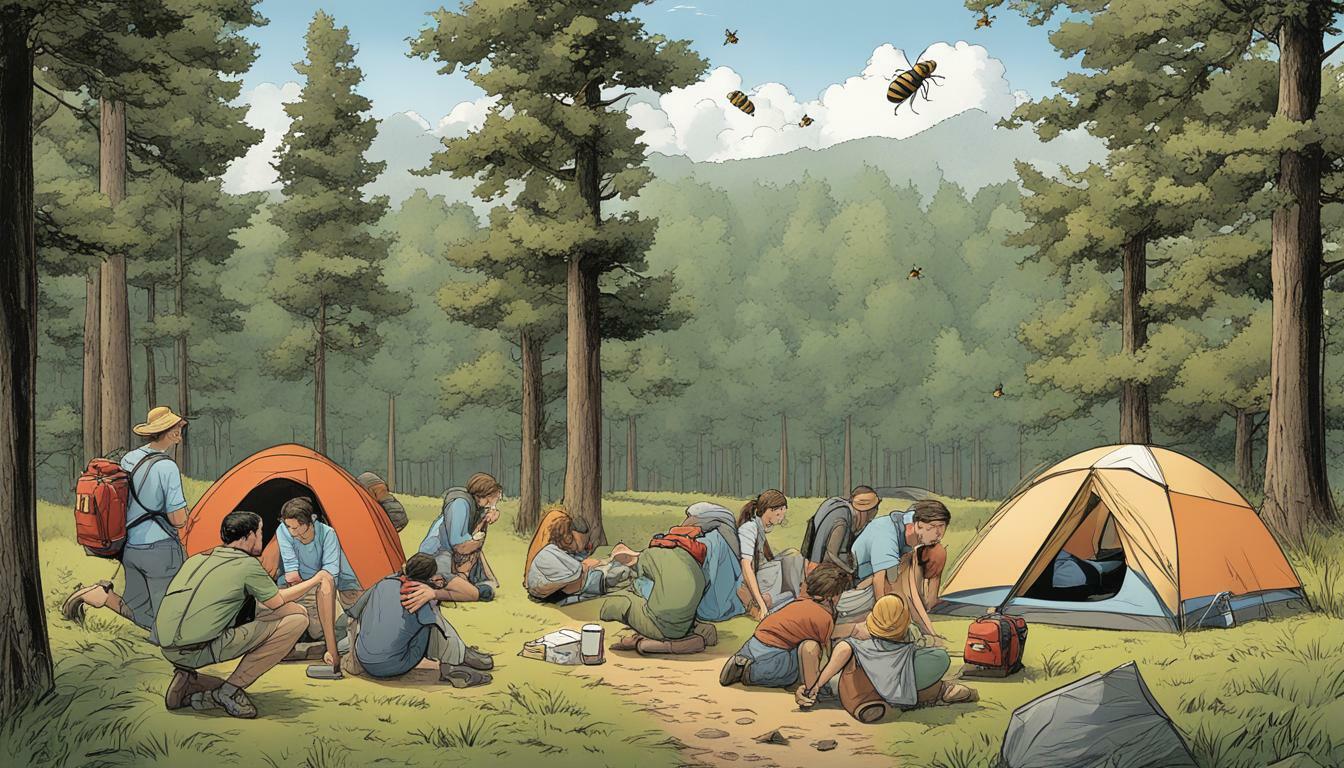
Conclusion
Being prepared for outdoor emergencies is essential for a safe and enjoyable summer. By knowing your surroundings, creating an emergency plan, carrying a first aid kit, and staying connected, you can help ensure that you and your loved ones stay safe in any situation.
Creating a Travel First Aid Kit
Summer vacations are a time for fun and relaxation, but accidents and illnesses can still happen. That’s why it’s important to be prepared with a travel first aid kit. Here are some essentials to include:
| Item | Purpose |
|---|---|
| Bandages (assorted sizes) | To cover small cuts and scrapes |
| Antiseptic wipes | To clean wounds and prevent infection |
| Gauze pads and medical tape | To dress larger wounds |
| Tweezers | To remove splinters or ticks |
| Antihistamine medication | To treat allergic reactions or insect bites |
| Motion sickness medication | To prevent or treat nausea while traveling |
| Sunscreen (SPF 30 or higher) | To protect skin from harmful UV rays |
| Insect repellent | To prevent insect bites and diseases |
| Blister pads | To protect and cushion blisters on feet |
Remember to tailor your kit based on your travel destination and any specific medical needs you or your family members may have. It’s also important to check your kit regularly and replace any expired or used items.
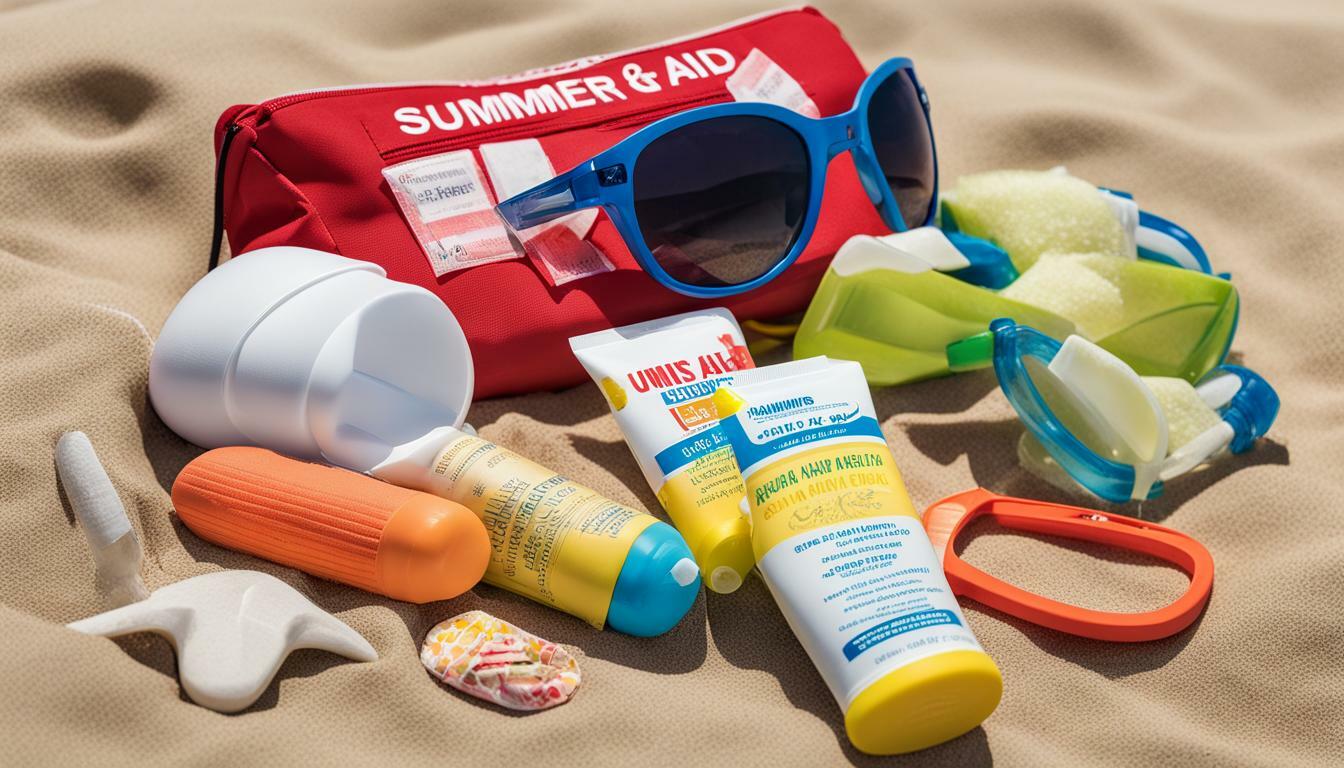
By packing a travel first aid kit, you can have peace of mind knowing that you’re prepared to handle common emergencies that may arise during your summer vacation.
Staying Safe in the Sun: SPF and UV Protection
With summer comes the need for sun protection. Sunburns not only hurt, but they can also cause long-term damage to your skin. To ensure you’re protecting yourself properly, it’s important to understand SPF and UV protection.
What is SPF?
SPF, or Sun Protection Factor, measures the amount of UVB radiation that a sunscreen can filter out. The higher the SPF number, the more protection it offers. For example, SPF 30 sunscreen blocks about 97% of UVB rays, while SPF 50 sunscreen blocks about 98%.
It’s important to note that no sunscreen can block 100% of UVB rays, and that higher SPF does not mean you can spend more time in the sun without reapplying.
Choosing the Right Sunscreen
Look for a broad-spectrum sunscreen that protects against both UVA and UVB radiation. It should have an SPF of at least 30 and be water-resistant if you plan on swimming or sweating.
If you have sensitive skin, consider using a mineral-based sunscreen with ingredients like zinc oxide or titanium dioxide. These sit on top of the skin and reflect UV rays, rather than being absorbed by the skin.
How to Apply Sunscreen
Apply sunscreen liberally 15 minutes before going outside, and reapply every 2 hours or immediately after swimming or sweating. Be sure to cover all exposed skin, including your face, ears, neck, and hands.
Use about a shot glass worth of sunscreen per application for your body, and a pea-sized amount for your face.
Additional Tips for Staying Safe in the Sun
- Wear a hat and sunglasses to protect your face and eyes.
- Seek shade during the hottest part of the day, usually between 10am and 4pm.
- Wear protective clothing, like lightweight long-sleeved shirts and pants.
- Drink plenty of water to stay hydrated.

By following these tips and properly using sunscreen with SPF and UV protection, you can enjoy the summer sun while also keeping your skin safe and healthy.
Conclusion
As summer approaches, it’s essential to be prepared for outdoor emergencies and common issues like sunburns and insect bites. By creating or updating your first aid kit with essential supplies like bandages, antiseptics, and sunscreen, you can avoid these emergencies. Additionally, following summer safety tips like staying hydrated, wearing protective clothing, and using insect repellent can help prevent illnesses and injuries.
If you do experience a sunburn or insect bite, be sure to treat it promptly by using aloe vera gel, cold compresses, and antihistamine creams. It’s also essential to learn how to prevent tick bites and safely remove ticks to avoid Lyme disease. If you encounter a jellyfish sting or symptoms of heatstroke, seek medical attention immediately.
Remember to check your first aid kit regularly and replace any expired or used items. Being prepared for outdoor emergencies is critical, and creating an emergency plan can help you stay safe during natural disasters or accidents.
By following these tips and staying informed about summer safety, you can make the most of your summer vacation without any emergencies. Stay safe and have fun!
